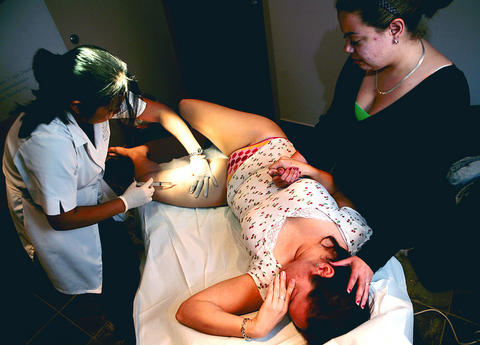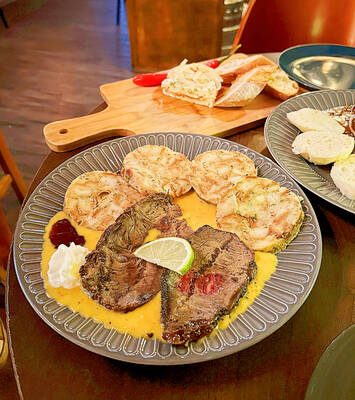Andrew Rudnick snickered when he first saw a medical spa offering Botox and laser hair-removal services on a visit to a Las Vegas mall in 2002. He laughed at the thought of someone - anyone - shopping for the latest fashions, grabbing a bite to eat and then, oh yeah, strolling in for a quick shot of Botox to zap out a nasty wrinkle.
"I couldn't understand why anybody in a mall would walk in and have their legs lasered, never mind Botox," he recalled. He parked himself on a bench near the spa and watched in amazement as shoppers strolled in. He owned a weight-loss and laser center in Boston at the time, and the sight was a revelation. "I counted the traffic in and out and saw the revenue."
Returning to Boston, he scouted retail locations. He dropped the weight-loss part of his business to focus on skin care and laser treatments, renamed the company and opened his first Sleek MedSpa that same year. He has since opened six more - near Boston and in New York and Florida, all in upscale malls or retail areas. "It took off like a bat out of hell," he said.

PHOTO: NY TIMES NEWS SERVICE
Thanks in part to television shows like Extreme Makeover and Nip/Tuck, the number of Americans seeking chemical peels, laser procedures, Botox shots and wrinkle-filler injections is soaring. According to the American Society for Aesthetic Plastic Surgery (ASAPS), such "noninvasive" treatments have increased more than 700 percent since 1997. Botox received Food and Drug Administration approval in 2002.
The stampede of doctors and entrepreneurs rushing to fill that demand has left some doctors and plastic-surgery trade groups wondering about the expertise of some of the people providing these services. For many Americans, price and convenience come first, with few questions about the experience and qualifications of the person injecting the treatments.
For its part, Sleek MedSpa says some of its outlets have on-site physicians while others have doctors as medical directors off-site and nurse practitioners and physician's assistants who handle day-to-day treatments. If there were an emergency a nurse couldn't handle, the nurse would call 911, Rudnick said. He added that no such emergency had ever arisen.
Kim Wanderley, 39, a stay-at-home mom from Parkland, Florida, said she thought it was "great" when she spotted a Sleek MedSpa at the Town Center mall in Boca Raton in 2006. "If it had been in Ohio, people might have blinked twice, but this is South Florida," where vanity rules, she said. "People do not take aging lightly, without a fight."
While Sleek MedSpas lack the feng shui ambience of a traditional beauty spa, they don't exude the sterile atmosphere of a doctor's office, either. The spa in Boca Raton is contemporary and sophisticated, Wanderley said, with videos of cosmetic procedures streaming across a flat screen, skin-care products lining another wall and before-and-after picture brochures scattered around the waiting room.
And it's convenient. "I can be in and out in a half-hour," she said, and "it gives me an excuse to go to the mall afterward to do a little shopping." If a procedure causes redness or bruising, the spa offers a convenient back-door exit.
Wanderley acknowledges that 10 years ago, she would have thought this "way too excessive and ridiculous," she said. "But now I'm one of the bozos on the bus." She started out requesting microdermabrasion facial treatments and has since added Botox shots and Restylane filler injections to her repertoire.
Rudnick estimates that 50 percent of his company's mall clients are walk-ins like Wanderley. Sleek MedSpa's revenue, which was US$1.5 million in 2002, surged to more than US$14 million last year, Rudnick says, and he expects that total to double this year. Profit margins are in the 20 to 25 percent range, he said, and over the next four years he expects to open 40 more locations in 25 cities.
Sleek MedSpa is among dozens of companies operating medical spas, often called medspas. Hannelore Leavy, founder and executive director of the International Medical Spa Association, estimates that there are 2,000 to 2,500 medspas nationwide, up from 25 in 2002.
There has also been a surge in the number of nonsurgical cosmetic procedures. Of the 11.5 million cosmetic procedures performed in 2006, more than four in five were noninvasive treatments, according to ASAPS. From 1997 to 2006, the number of surgical cosmetic procedures rose 98 percent, and noninvasive treatments jumped 747 percent.
Nonsurgical treatments "are effective, they're safe and they're affordable - and there's no down time," said Foad Nahai, a plastic surgeon in Atlanta and president of the society.
Industry experts attribute the surge in cosmetic procedures to aging baby boomers as well as to television shows.
Marian Salzman, author of more than a dozen books on cultural trends and current affairs, said she predicted 10 years ago in Next: Trends for the Near Future that cosmetic procedures would become mainstream.
Affordable and walk-in cosmetic surgeries were among the trends she had forecast, Salzman said. "I used to say they're going to be as prevalent as salons," she recalled, adding that "people used to roll their noses up at me and say it's obscene, it's ridiculous."
Nahai and other plastic surgeons worry that shows like Extreme Makeover gloss over the risks, and edit out the bruising and recovery. "I tell every patient - forget the word 'cosmetic,' and remember the word 'surgery,'" he said. "And there's no such thing as surgery without risk."
Lou Gorfain, an executive producer of Extreme Makeover, which was broadcast on ABC, dismissed such criticism, saying, "We did show the bruising and the pain and risky surgery that it is." And Linda Klein, a producer and medical adviser of Nip/Tuck, said the series tries to show that surgery is "not a pretty sight" - and emphasized that the show is fictional.
The death of Kanye West's mother in November from complications following a tummy tuck and breast reduction surgery pushed concerns about procedures into the spotlight.
Sometimes, surgical horror stories can make noninvasive procedures look more attractive. Still, even nonsurgical procedures, like Botox shots and laser treatments, have their own risks, especially if the person giving the treatment isn't fully trained, cautioned Richard D'Amico, president of the American Society of Plastic Surgeons and chief of plastic surgery at the Englewood Hospital and Medical Center in Englewood, New Jersey. In the wrong hands, he said, lasers can burn and Botox can cause drooping eyelids or paralysis until the toxin wears off in three to six months.
In the most dire case, if an injection gets into a blood vessel and the product gets into the retinal artery, a patient could be blinded, D'Amico said.
He said it was crucial that people check the credentials and experience of those who offer cosmetic treatments.
In addition to Sleek MedSpa, the industry includes chains like Sona MedSpa International, Pure Med Spa, Dermacare Laser and Skin Care Clinics and American Laser Centers, which was recently sold to two private equity firms for about US$230 million.
Despite the boom, some other medspas have flopped. Skin Nuvo International, which operated 40 mall-based clinics, had problems with its hair-removal equipment and wound up filing for Chapter 11 bankruptcy protection in 2005. And HealthWest Inc and SkinKlinic have closed shop.
Rudnick is bullish on the sector's growth and is already planning a network of full-service cosmetic surgery facilities. The first opened adjacent to his New York medspa in October.
"We know one thing for sure: people aren't getting any younger," he said. "We know another thing for sure: they all want to look younger."

Seven hundred job applications. One interview. Marco Mascaro arrived in Taiwan last year with a PhD in engineering physics and years of experience at a European research center. He thought his Gold Card would guarantee him a foothold in Taiwan’s job market. “It’s marketed as if Taiwan really needs you,” the 33-year-old Italian says. “The reality is that companies here don’t really need us.” The Employment Gold Card was designed to fix Taiwan’s labor shortage by offering foreign professionals a combined resident visa and open work permit valid for three years. But for many, like Mascaro, the welcome mat ends at the door. A

Divadlo feels like your warm neighborhood slice of home — even if you’ve only ever spent a few days in Prague, like myself. A projector is screening retro animations by Czech director Karel Zeman, the shelves are lined with books and vinyl, and the owner will sit with you to share stories over a glass of pear brandy. The food is also fantastic, not just a new cultural experience but filled with nostalgia, recipes from home and laden with soul-warming carbs, perfect as the weather turns chilly. A Prague native, Kaio Picha has been in Taipei for 13 years and

Since Cheng Li-wun (鄭麗文) was elected Chinese Nationalist Party (KMT) chair on Oct. 18, she has become a polarizing figure. Her supporters see her as a firebrand critic of the ruling Democratic Progressive Party (DPP), while others, including some in her own party, have charged that she is Chinese President Xi Jinping’s (習近平) preferred candidate and that her election was possibly supported by the Chinese Communist Party’s (CPP) unit for political warfare and international influence, the “united front.” Indeed, Xi quickly congratulated Cheng upon her election. The 55-year-old former lawmaker and ex-talk show host, who was sworn in on Nov.

The Western media once again enthusiastically forwarded Beijing’s talking points on Japanese Prime Minister Sanae Takaichi’s comment two weeks ago that an attack by the People’s Republic of China (PRC) on Taiwan was an existential threat to Japan and would trigger Japanese military intervention in defense of Taiwan. The predictable reach for clickbait meant that a string of teachable moments was lost, “like tears in the rain.” Again. The Economist led the way, assigning the blame to the victim. “Takaichi Sanae was bound to rile China sooner rather than later,” the magazine asserted. It then explained: “Japan’s new prime minister is